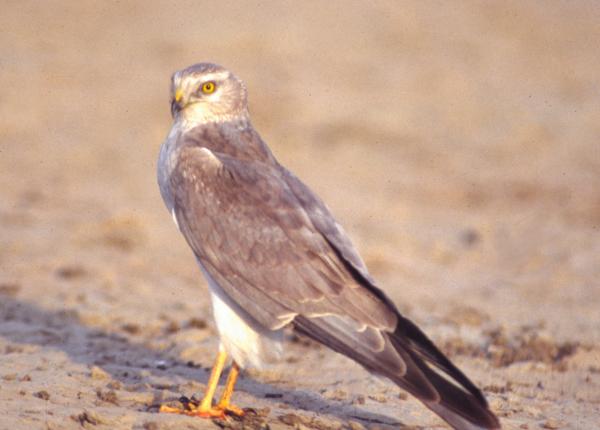Did You Know?
- This species is also known as the Pale Harrier
- The Pallid Harrier is migratory and during migration, several hundred individuals might roost together.
- To date, the oldest known Pallid Harrier is 13 years old.
How The Peregrine Fund is Helping
Though The Peregrine Fund doesn't work directly with Pallid Harriers, our efforts in scientific research, habitat conservation, education, and community development help conserve raptors on a global scale. We also supply literature to researchers from our avian research library, which helps scientists around the world gather and share important information on raptor conservation.
Where They Live
This species have a generally wide range across parts of Europe, Asia, the Middle East and Northern Africa. Especially during breeding season, it favors open habitats including steppes and grasslands, agricultural areas, taiga, open areas near woodlands, and occasionally marshes.
What They Do
Harriers are famous for their graceful, low flights with their wings held in a wide "v" shape. The Pallid Harrier is no exception. It is a stunning bird and, like the Northern Harrier, the male and female differ in coloration. This is known as sexual dimorphism. In the case of the Pallid Harrier, the male is a mixture of pale grays and whites, with black wing tips. The female is browner, overall. They both have bright yellow eyes and a distinctive facial disk.
Right about now, you might be asking yourself what exactly is a facial disk? A facial disk is composed of feathers that form a circle around its face. The disk can be lifted or lowered at will. When the feathers of the facial disk are raised, they help direct sounds to the bird's ears. To see how this works, cup your hands behind your ears and listen. You might notice that whatever you are listening to seems louder. When a PallidHarrier is hunting over dense grass or other vegetation, it listens for the sounds of its prey scurrying below and knows where to aim its sharp talons.
The Pallid Harrier is a diurnal raptor, meaning it is active during the day and rests at night.
Why They Need our Help
This beautiful harrier's populations are in decline in much of their range. It is categorized as Near Threatened, and the main threats it faces are destruction and degradation of its habitat due to burning (natural and man-caused), conversion into farming lands, or over grazing.
What They Eat
The Pallid Harrier hunts by flying low over the ground, in search of prey. It feeds on rodents, such as mice, voles, lemmings, and ground squirrels. It will also take birds, particularly small terrestrial passerines, like larks. It also feeds on bird eggs and nestlings. But, its long list of prey items doesn't stop there. It will also consume lizards, other small reptiles, frogs, and insects, such as locusts and dragonflies.
Like some other raptors, it attends grass fires, catching insects and other small animals fleeing the smoke and flames.
Nest, Eggs, and Young
These lovely harriers nest on the ground, usually in a heap of grass surrounded by vegetation. The female will lay anywhere from between 3-6 bluish-white eggs with brown markings. After the eggs are laid, the female will incubate them for around one month. incubation by female, period 29–30 days per egg, During this time, the male works hard to find food for himself and the female. When then nestlings hatch, they acre covered in an off-white down. They will grow quickly and in just 6 or 7 weeks, they will be ready to fly from the nest for the first time. After they begin flying, they will stay with their parents for another few weeks as they learn to survive on their own.
Pallid Harrier and The World Center for Birds of Prey
If you would like a chance to see a harrier in the wild, a visit to our World Center for Birds of Prey is a good place to start. Northern Harriers can be seen around The Peregrine Fund's World Center for Birds of Prey. As you drive up to the entrance, watch for them soaring low over the grassy fields on either side of the road. When walking our nature trail, be sure to look for these graceful, agile raptors. An interpretive sign at the end of the trail teaches you how to identify a raptor based on its silhouette. Additionally, the Velma Morrison Interpretive Center offers fun ways to learn about birds of prey. Interactive activities, tours, interesting videos and a children's room with activities from coloring sheets to quizzes to costumes are all available for our guests. We also have knowledgeable, on-site staff to answer any questions you may have about Pallid Harriers, or any other bird of prey.
References:
Global Raptor Information Network. 2022. Species account: Pallid Harrier Circus macrourus. Downloaded from http://www.globalraptors.org on 23 Nov. 2022
Orta, J., D. A. Christie, and G. M. Kirwan (2020). Pallid Harrier (Circus macrourus), version 1.0. In Birds of the World (J. del Hoyo, A. Elliott, J. Sargatal, D. A. Christie, and E. de Juana, Editors). Cornell Lab of Ornithology, Ithaca, NY, USA. https://doi.org/10.2173/bow.palhar1.01










